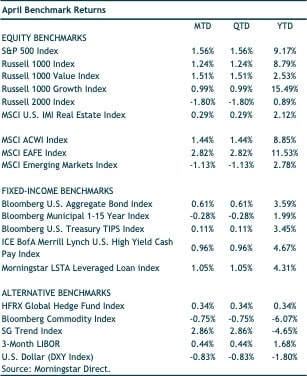May 2023 Market Commentary
- Global equities rose in April amid regional banking stress and worsening leading economic indicators
- Despite the worries, the economy remains resilient and has yet to contract
- Investors waited for the Fed’s early May rate decision—widely believed to the last rate hike in this cycle
- Regulators seized First Republic Bank and sold its assets to JPMorgan Chase
MARKET RECAP
Equity markets rose during the month, led higher by developed markets. European markets outperformed all the main regains with a gain of 4.2%. The S&P 500 returned 1.6% in April. Emerging markets underperformed (down 1.1%) due to weakness in Chinese equities (down 5.2%).
While the S&P 500 Index is up 9.2% so far this year, the narrowness of the market has been notable. A recent Goldman Sachs report noted that 90% of the S&P 500’s year-to-date return is accounted for by the largest 15 stocks. Look no further than the FANG stocks which have clocked in a return of more than 30% this year. It has paid to own the largest names in the index. The S&P 500 Equal Weighted Index is up just 3.3% this year, nearly 600 basis points behind the S&P 500 (market cap weighted index).
Interest rates were largely unchanged during the month (also reflecting relative disregard for the regional banking issues). The 10-year Treasury rate started the month at 3.48% and ended at 3.44%. The Bloomberg US Aggregate Bond Index gained 0.6%. Riskier credit slightly outperformed the core bond index. The ICE BofA US High Yield market gained 1.0%.
NOTABLE EVENTS
The month was filled with mixed data on the economy as investors waited for the May FOMC meeting. First quarter real GDP growth came in at 1.1%, which was below consensus of 1.9%. It was a notable slowdown from 2.6% GDP growth in the previous quarter. However, first quarter GDP was not a result of weak consumer spending (real personal consumption expenditures increased 3.7% in the quarter). The drag on first quarter GDP was declining business inventories.
Leading indicators on the economy are declining and the economists projecting a recession have adjusted their timeline to the second half of 2023 or early next year. If such a scenario comes to pass, we could see downward pressure on stocks given the equity and credit markets are not priced for a recessionary environment.
The May 2-3 FOMC meeting was the anticipated event throughout much of April. Despite banking stress and inflation double the Fed’s 2% target, it was largely expected that a 25 basis points increase in the fed funds rate was in the works (bringing the target range to 5%-5.25%). The Fed followed through on this, which is now widely expected to be the final rate hike in the current hiking cycle. The CME futures market has it at a 100% certainty that the Fed will cut rates multiple times between now and the end of the year. This is one of the big divides in the market—the Fed and Chair Powell want to hold rates at these levels for an extended period; however, the market is expecting a U-turn in short order.
TAKEAWAYS
While we remain cautious about the market and economy, we understand that the “soft landing” scenario is possible (even if the probability is shrinking amid tightening lending standards as a result of the banking issues). Should markets continue higher while economic readings continue to deteriorate, we would re-visit reducing risk in portfolios.


